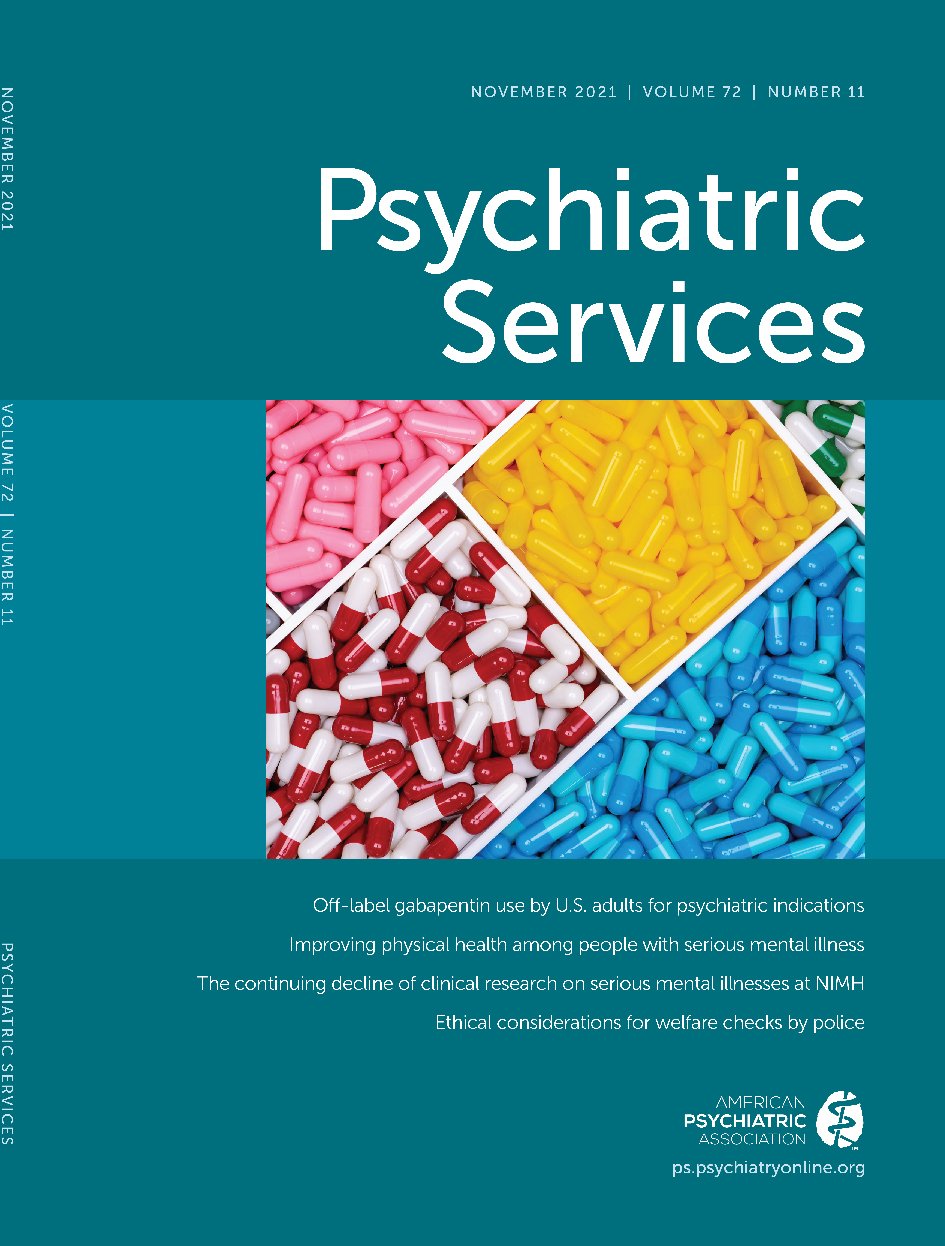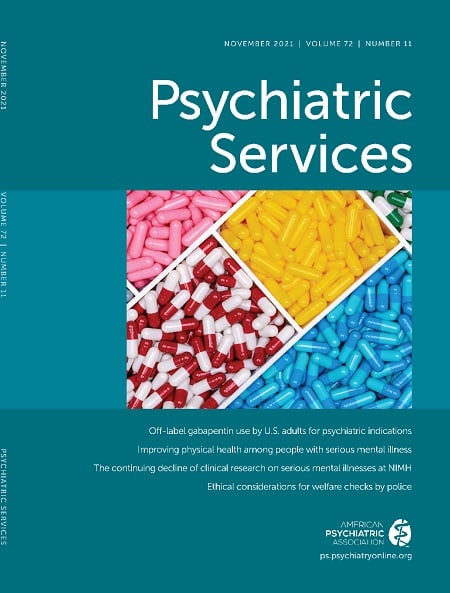In the United States, there are approximately 500,000 annual emergency department (ED) visits for self-harm (
1), and these patients are at high risk for suicide (
2) and repeated self-harm (
3). Over 40% of adults who die by suicide have one or more ED visits in the previous year (
4), suggesting that EDs have an opportunity to deliver critical frontline suicide prevention.
Several practices are widely recommended for ED management of patients presenting with self-harm, including suicide risk assessment, access to means assessment, safety planning, and connecting patients with outpatient mental health care. When implemented together, these practices help detect subsequent risk of suicide (
5), reduce the risk of repeat self-harm (
6), and provide access to mental health services (
7). It is recommended that hospitals use a validated screening tool and detailed suicide risk assessment to inquire about self-harm behaviors, intent, means, and plan; establish connections with outpatient mental health providers (
8); and provide counseling and follow-up care. The safety planning intervention (SPI), a brief behavioral intervention that teaches coping skills, identifies social and emergency networks, restricts access to lethal means, and builds motivation for follow-up mental health treatment, has been found to lower the risk of suicidal behaviors and increase treatment engagement after ED discharge (
6).
Despite research and recommendations supporting these practices for ED patients presenting with self-harm, they are not routinely implemented in U.S. EDs. A national analysis of Medicaid patients found that fewer than half of discharged patients who presented with self-harm received a mental health assessment in the ED, and almost half did not attend a follow-up outpatient visit in the month postdischarge (
9). Furthermore, in a large-scale national survey of ED directors, only 15.3% reported routinely implementing safety planning (
10).
There has been limited research on the extent to which hospital and community factors influence the provision of ED care of patients at risk for suicide. One study (
10) found that, compared with nonteaching hospitals, EDs in teaching hospitals were significantly more likely to provide patients presenting with self-harm a contact list of local mental health professionals and agencies. Understanding which ED characteristics influence the routine incorporation of risk assessment, access to means, safety planning, and discharge planning can inform efforts to improve widespread implementation of effective suicide prevention practices in EDs.
Methods
A survey reviewing ED management of self-harm was mailed between May 2017 and January 2018 to a weighted random sample of 665 ED nursing directors at hospitals selected from 2,228 hospitals with five or more self-harm visits in the previous year, as identified from national Medicaid claims data. The survey used a 4-point Likert-type scale to assess the routine provision of mental health services to their general caseload of ED patients after an episode of self-harm. Self-harm was defined in the survey as nonfatal self-poisoning or self-injury with or without suicidal intent (
11). The survey response rate was 77% (N=513) and 494 EDs were included in this analysis (19 children's hospitals were excluded). The University of Pennsylvania Institutional Review Board approved the study.
The survey included questions about the extent to which EDs routinely provide recommended services to patients presenting with self-harm, including discharge practices (“For patients discharged during standard weekday hours, how often is a follow-up outpatient appointment scheduled before they leave the ED?”), assessment practices (assessing current and past suicidal ideation and access to means to carry out these plans), and safety planning (completing at least four of the following six elements to help patients: recognize warning signs that immediately precede a suicidal crisis, learn strategies to take their mind off problems, identify social activities that provide distraction from their problems, identify family members and friends to ask for help, provide a list of professionals and agencies to contact in a crisis, and develop an individualized plan to make their home safer by removing or restricting access to lethal methods). Survey responses were dichotomized into “on a routine basis” and “not on a routine basis” (never or rarely, sometimes, usually but not routine). For the assessment questions only, the survey asked whether a standardized template was used (yes, no), and the response had to be “yes” for these questions to be considered “on a routine basis.”
Hospitals were characterized by the following variables as determined from the survey: having a separate psychiatric ED (yes, no), mental health staffing (high, low) (
12), having formal contractual relationships with outpatient providers (yes, no), and weekly number of patients with mental health as a primary complaint (0–100, ≥101).
Survey data were also linked to the American Hospital Association Annual Survey of Hospitals. Hospital variables included hospital patient volume (tertiles), location (urban, rural), teaching status (yes, no), and ownership (private for profit, private not for profit, and government). Finally, relevant county-level factors were identified in the Area Health Resource Files (
13): mental health care professional shortage area (whole county, part or none of the county), psychiatry staffing for patient care per 100,000 population (≤5, 6–17, ≥18), race (White, non-White), percentage of the population in poverty (≤70.1%, 70.2%−85.0%, ≥85.1%), and 3-year average rate of death by suicide per 100,000 population (≤11, 12–15, ≥16).
All analyses were conducted at the hospital level on the basis of survey responses regarding aggregate practices as reported by nursing directors, medical directors, and other staff. First, the overall rates of assessment, SPI, and discharge practices were examined. Analyses of EDs that routinely engaged in these practices and those that did not were then stratified by hospital characteristics and compared by using chi-square analyses. All analyses included survey weights to accommodate the sampling design that selected hospitals with probability proportional to their self-harm patient volume to produce representative estimates of the 2,228 EDs from which the random sample was drawn. Analyses were conducted with SAS, version 9.4.
Results
Overall, 39% of respondents reported routinely scheduling follow-up outpatient appointments for patients presenting with self-harm before they were discharged from the ED during standard weekday hours. Almost three-quarters (73%) assessed current suicidal ideation and past suicidal thoughts and behaviors, and 61% assessed access to means. Finally, 30% completed at least four safety planning elements.
There were few significant differences between EDs that routinely provided these recommended practices and those that did not, with regard to hospital (
Table 1) and community characteristics (see
online supplement). First, EDs that routinely scheduled follow-up appointments had different sets of formal contractual arrangements for scheduling outpatient mental health facilities, compared with EDs that did not routinely schedule follow-up appointments, with the largest difference being for those that had contractual arrangements for all of their patients (43% versus 25%, p=0.005). Second, EDs that routinely completed at least four SPI elements were significantly more likely to have a high level of psychiatrist or psychologist staffing, compared with EDs that did not routinely complete these elements (60% versus 46%, p=0.032). Finally, EDs that routinely assessed current and past suicidal ideation or plans and assessed access to means were significantly more likely to be in communities with higher average suicide rates (both p=0.010).
Discussion
Few differences distinguished the characteristics of EDs that routinely provided the recommended practices and those that did not. However, a substantial proportion of EDs did not routinely provide these practices. Specifically, EDs were least likely to provide safety planning elements, followed by scheduling follow-up outpatient appointments, assessing access to means, and assessing current suicidal ideation. This finding suggests that there is considerable room for improvement across hospital characteristics.
Two characteristics—formal ED relationships with outpatient providers and level of psychiatric staffing—were significantly related to individual recommended practices. Focusing on developing or strengthening existing relationships with mental health care providers, both inside and outside of the hospital, could help improve care for patients presenting with self-harm. Hospitals could establish crisis clinics or dedicated psychiatric emergency service units that provide onsite evaluation and treatment, significantly improving patient access to care (
14). Unfortunately, the required financial, infrastructure, and staffing investments may limit feasibility for many hospitals, particularly smaller or rural hospitals. Instead, leveraging shared resources to pursue the development of a county- or regional-level nexus of care could improve mental health care across a broad geographic area. For example, in one California region, local EDs transfer patients to a regional psychiatric emergency hospital that provides comprehensive 24-hour care and has significantly reduced boarding time and improved patient stabilization (
15). This arrangement may depend on policy and funding shifts that promote regional cooperation and comprehensive mental health care. In the interim, hospitals could consider formalizing partnerships with local community-based mental health care providers, increasing reliance on telepsychiatry, hiring dedicated mental health staff, or training existing ED staff in established interventions, such as SPI.
The study had several limitations. First, it measured perceptions of service provision rather than patient-level service delivery. Second, use of self-report rather than service delivery audit may be more subject to social desirability bias, although respondents were assured that the identity of their facilities would be kept confidential. Third, nonresponse may have resulted in selection bias, although the response rate exceeded 70%. Fourth, although responses were primarily from nursing directors (78% had input from nursing leadership) who may have had varying perspectives and different levels of knowledge of all clinical practices that occur on the unit, they were targeted because of their management of typical unit policies and practices. Fifth, the survey was limited to hospitals that treated at least five Medicaid-financed patients for self-harm during the year before the survey, so the results may not generalize to EDs with lower patient volume. Finally, we were unable to distinguish hospitals by the patient risk profiles that might influence disposition decisions, such as inpatient admission versus discharge to the community.
Conclusions
Our findings provide evidence that patients who present with the risk of self-harm may not routinely receive appropriate, recommended care. However, because there were few differences in the hospital and community characteristics of EDs that routinely provided this care and those that did not, implementation of these practices may be possible at a wide range of hospitals. Identifying local community-based partners and training existing ED staff are two promising approaches for increasing the provision of recommended practices for managing ED patients at high risk for suicide.

